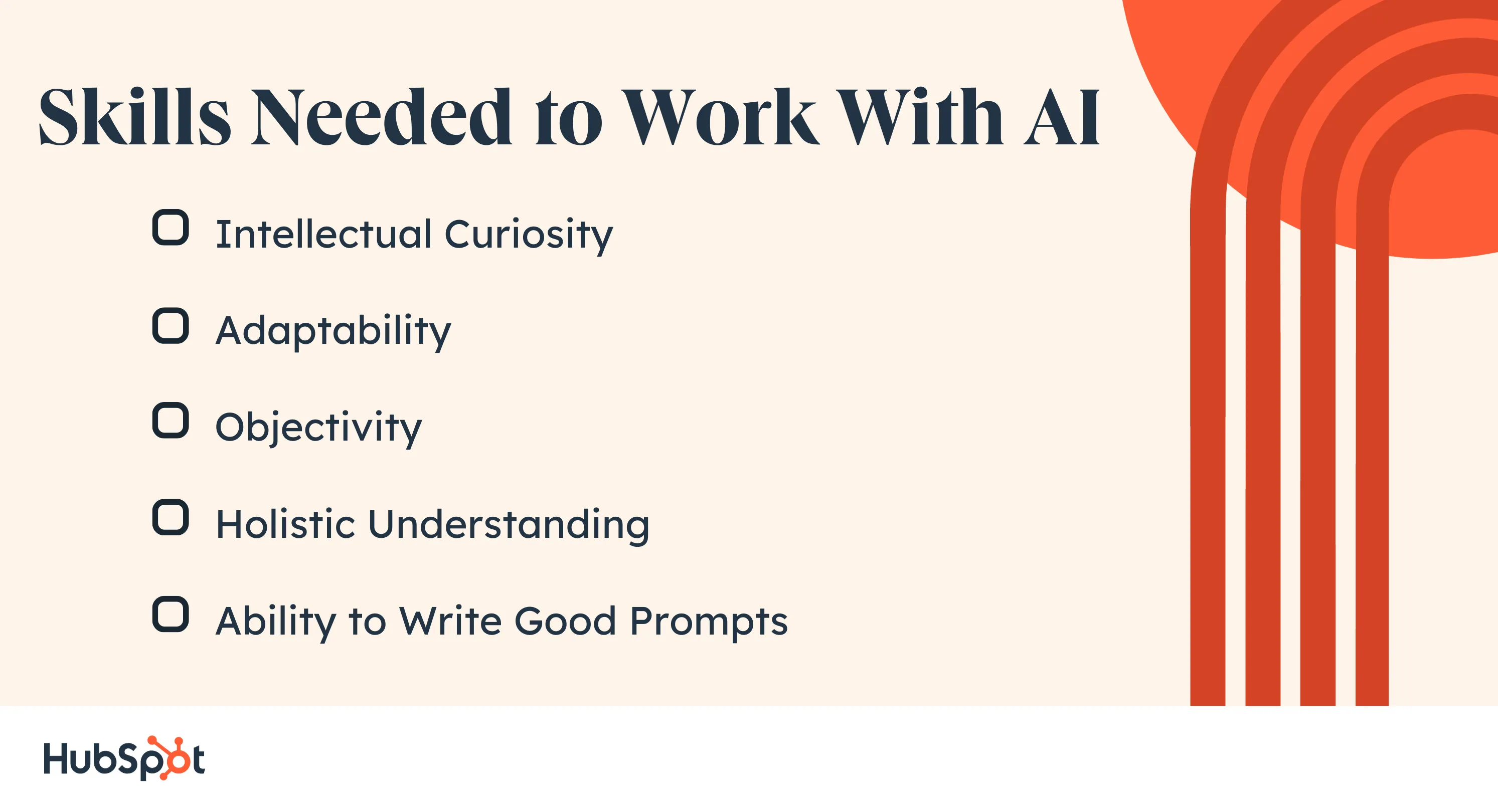“Will AI steal my job?” For the last few decades, this question has been on the lips of nearly every working person — from baristas in coffee shops to project managers in decacorn companies. The launch and impact of ChatGPT in November 2022 added fuel to the fire and has made this conversation more popular than ever.

Now that it seems that a robot or computer can do just about any job these days — writing software code, generating content outlines, and completing tax forms — how can human beings remain employed in the future?
Turns out, there are some non-technical skills that AI cannot replicate. If you’re going to be navigating the employment space in this AI era, you’ll need to develop these intangible skills. They’ll not only give you an edge over AI, but they’ll also enhance your overall work performance and career growth.
In this article, you’ll learn the skills you need to work with AI, the skills AI can’t replace, and how to boost your critical thinking skills to stay afloat in the AI era.
Table of Contents
Skills Needed to Work With AI
If you use AI tools at work, here are some skills you need to make the most of these tools.
1. Intellectual Curiosity
Intellectual curiosity is a person’s desire and willingness to dig deeper than the surface to learn new things.
As a professional working with AI-powered tools, this soft skill helps you analyze the information the tool generates and ask the necessary questions to determine whether that information can help you achieve your goals or not.
For example, a social media manager can ask ChatGPT to whip up a social media strategy for the kind of company they work for (e.g., SaaS, tech, law firm).
However, the social media manager won’t just implement the AI-generated strategy as is.
Instead, they’ll dig deeper into the base strategy to figure out what part each component (social media platform, post format, etc.) plays and how to customize it to align with the company’s product(s), target audience, and goals.
Intellectual curiosity helps you approach your work with more creativity. Instead of sticking with what worked in the past, you’ll leave your comfort zone, think outside the box, and come up with solutions — sometimes unconventional — that are more effective than anything you’ve tried before.
2. Adaptability
No matter what your industry is or what role you occupy, the ability to adapt to change quickly is something you need, even when you’re using AI in your work.
The business world is constantly evolving, but once an AI tool is programmed, it can’t change without outside intervention. So, it’s up to you as an employee to be willing to adapt to the changes in the workplace environment and take on different responsibilities as required.
Being adaptable doesn’t only give you the opportunity to try out new strategies, but it also displays your leadership skills and showcases your ability to be resourceful, analytical, and determined. These are all qualities that hiring managers look for in a potential employee.
3. Objectivity
One of the most common misconceptions about AI is that it is an inherently objective and impartial work partner that has all the right answers. This couldn't be further from the truth.
Humans are biased in nature and are predisposed to subjective truths. The AI tools they create also inherit that bias. Google’s Chief Decision Scientist, Cassie Kozyrkov, uses the Cat vs. Not-Cat example to illustrate this pitfall.
Say an AI expert creates a machine-learning model that determines which animals in these six pictures are cats and which ones aren’t.
From image 1 to image 5, it’s pretty obvious which animals are cats (versus not cats). However, the way the ML model will categorize the sixth image depends on whether the AI expert considers a tiger to be a cat or not.
We all know the tiger belongs to the cat family, but is it actually a cat compared to the animals in images 1, 3, and 4? Is it a different type of cat? And if it is, will it be right to put it in the same category as domestic cats?
The answer depends on the subjective truth the AI expert believes in.
In her piece, “Why AI and decision-making are two sides of the same coin,” Cassie Kozyrkov writes, “AI cannot set the objective for you — that’s the human’s job and machine learning’s ‘right’ answers are usually in the eye of the beholder, so a system that is designed for one purpose may not work for a different purpose."
If, in the example above, the AI expert programs the model to determine that the animal in image 6 isn’t a cat, they’d be right in a sense. But if you, who uses the model, think the animal is a cat, you’d be right, too.
“From the experiments our team has performed, AI works best when the result can be subjective (art, writing, idea generation, etc.) or when some error is tolerable (data classification),” says Blake Burch, the co-founder at Shipyard.
“When you need something to be 100% right, you can only rely on the AI output if you have other ways to verify the accuracy like code execution or undergoing human-in-the-loop review.”
There’s never a “right” way for AI to define categories that everyone would agree with. It’s up to you to choose what to believe and replicate.
4. Holistic Understanding
Holistic understanding is the understanding of the relationship between the components of a whole system.
In business, a holistic approach connects every department in an organization and helps them work as one team toward achieving the business’s overall goals.
If you use AI tools, it’s important to understand how your work benefits the company as a whole and figure out how to work with other teams, no matter how far removed they may seem from you.
For example, it’s easy to see how the Product and Marketing teams are related and how their work impacts each other, but it’s harder to see how the Product and Legal teams are related. Holistic understanding helps you make that connection.
As Brian Rhea from JobLens.ai puts it, “Humans are remarkably good at Holistic Understanding: our ability to connect seemingly unrelated information and experiences in order to draw a meaningful, creative insight.
All those ‘What I Learned about Marketing from Game of Thrones’ posts resonate for a reason. We are much better than AI at drawing lessons from recurring — but unrelated — patterns in life.”
Pro tip: A great way to foster holistic understanding in the workplace is to use project management and communication tools like Trello, Asana, and Slack to communicate and distribute information across teams.
5. Ability to Write Good Prompts
If there’s anything ChatGPT has taught us, it’s that knowing how to write good prompts makes all the difference in the quality of information we get from generative AI tools.
Thankfully, newer generative AI tools allow you to be *really* specific and creative with your prompts. This increases your chances of getting information that’ll be useful to you.
For example, say you’ve been tasked to explain quantum chromodynamics (hey, Young Sheldon fans!) to students in middle school and college.
Instead of racking your brain trying to turn this complex concept into something 12-year-olds can understand, you can ask ChatGPT, specifying the age or grade the students are in.
So instead of, “Explain what quantum chromodynamics is,” your prompt could be “How can I explain quantum chromodynamics to a middle school student/12-year-old child?”
And here’s what you’ll get:
Notice the parallels ChatGPT draws between gluons and magnets. That’s something a kid would understand. But if you ask ChatGPT to explain quantum chromodynamics to a college or postgraduate student, here’s what you’ll get:
Notice how the answer is longer and has more complex terms like “hadrons,” “asymptotic freedom,” and “large hadron collider.” But this won’t be a problem because you’ll be discussing with people with a higher understanding of the topic.
The point here is: If you want to make the most of AI tools, you need to know how to write great prompts. Be as specific and direct as possible, and adjust your prompts accordingly to get different results.
Skills AI Can't Replace
AI might be really effective at some things humans used to do as part of their work, but there are some skills humans have that AI can't replace. Here are some of them.

1. Critical Thinking
In a Q1 study of LinkedIn job listings, over 564,000 of them listed “critical thinking skills” as a requirement for a role. This goes to show just how much importance companies place on an employee’s ability to think well.
Crystal King, a professor at HubSpot Academy says, “Great inbound marketers and salespeople think critically and creatively, share thoughts and opinions, use good judgment, and make sound, educated decisions.”
And therein lies the Achilles’ heel of artificial intelligence.
Despite the superior ability of AI tools to analyze data, they cannot make well-informed judgments and decisions — a skill that’s necessary in different fields, including business, law, and medicine.
For example, a law firm can use advanced AI tools to find relevant documents in legal cases, but we still need a human judge and jury to listen to the facts of the case and adjudicate a decision.
2. Empathy
AI tools can assess a situation and respond to it. A human being, however, has to figure out the best way to communicate that response to others, especially in distressing situations.
For example, doctors may use AI to identify diseases on a scan, but they wouldn’t break the news of a cancer diagnosis to a patient via robocall.
The reason is simple: AI tools can’t genuinely understand human emotions and respond to them appropriately — at least not yet.
It’s not only the field of medicine that requires empathy, though. Customer service teams in all kinds of companies also need empathetic people.
"AI-powered customer success systems can assist with ticket routing, but nothing beats the human touch when it comes to sensitive or urgent concerns,” says Seth Besse, the CEO of Undivided.io.
“In moments of crisis, a compassionate approach and tailored support can make all the difference. Striving for excellence in customer service requires finding a balance between the efficiency of AI and the personal touch of human interaction. This approach ensures clients' unique needs are met with care and effectiveness.”
Besse’s right. Despite the progress we’ve made with affective computing, jobs that require empathy won’t be outsourced to AI any time soon.
3. Emotional Intelligence
Emotional intelligence is the ability to manage your emotions and understand the feelings of people around you.
Working in a team means people with different personalities and emotions surround you. And since AI doesn’t have emotions itself, it’s near impossible for it to effectively understand, let alone manage, your emotions and those of your team members.
On being emotionally aware and sensitive, Dominik Maka, the Head of SEO at LVBET, delineates, “AI‘s cool, but can it understand that sigh of relief from a client when you solve a problem they’ve been stressing over? Or that excitement in a team member‘s voice when they have a breakthrough idea? That’s the magic of empathy and emotional intelligence.
“It‘s something that’s been invaluable in my journey, especially when navigating the diverse cultures and markets. While I‘m all for AI and its wonders, there’s a warmth that we humans bring to the table. It‘s like comparing an AI-generated song to one where you can feel the artist’s soul.”
Whether it’s a team leader helping employees through a difficult project, hiring managers finding the best candidate for a role, or salespeople trying to convert leads into paying customers, emotional intelligence is a necessary ingredient to success.
In granular teams, emotional intelligence helps you keep the peace, boost innovation, and enhance productivity.
On a larger scale, it keeps a brand in tune with its customers, which, according to Kristin Harper, the CEO of Driven to Succeed, helps it “develop and charge a premium for innovative products and services, deliver more relevant advertising, and engage with customers in a way that is distinct and preferred versus their competitors."
4. People Management
People management is the process of hiring, training, and developing employees to support the organization’s mission, increase workplace productivity, and promote professional growth.
Sure, AI can sort through resumés during the hiring process, list tasks, and assign deadlines, but it doesn’t hold up well when it comes to actually leading and motivating employees.
Successful people management takes a combination of creativity, innovation, and emotional intelligence — a talent that people develop through experience and time.
It’s that talent that helps human leaders delegate tasks to the right individuals, put processes in place to help employees through difficult projects, resolve conflicts in the workplace, and inspire a team to achieve their goals.
5. Creativity
Creativity (and innovation) is the reason we have amazing inventions like music, automobiles, smartphones, search engines, and artificial intelligence.
Sure, AI is now being used to make these products more advanced, but even that is a product of the creativity that their human inventors possess — something that AI cannot, by itself, replicate.
On the one hand, AI is programmed. And on the other, creativity is spontaneous and requires imagination and inspiration.
An obvious example is content creation -- something many marketers use ChatGPT and other generative AI tools for.
Gabriel Ramuglia, the founder of IOFLOOD used GPT4 to produce SEO content articles.
Based on his experience, Ramuglia says, “While AI tools can generate many types of factual content, they struggle to reflect genuine human experience. This nuance, the intangible value of lived experiences, personal anecdotes, and wisdom from past situations, remains a blind spot in AI-generated content.”
This sentiment is echoed by Andrew Boyd, the co-founder of Forte Analytica.
While Boyd recognizes that AI can beat humans at writing content at a large scale, he recognizes that it cannot “give a personal take on a product or service that is authoritative and grounded in real-world experience.
“You can tell it to write from the perspective of someone who has done or used something, but even then it is still skin deep and tends to make sweeping generalizations. It lacks the nuance of a human since it cannot experience life as a human.”
6. Strategic Thinking
Many businesses are starting to automate a large chunk of their marketing practices — and rightly so. It is generally cost-effective and frees up time for employees to do work that matters.
However, human employees have to create the overall strategy themselves before automating any part of it.
For example, you can tell an AI-powered scheduling tool to send a Tweet (or is it Xeet?) for you at a specific time of day from Monday to Friday. However, the automation of those tweets is likely a small part of a larger strategy to distribute content, drive traffic, and generate qualified leads for the company.
The creation of that strategy is not the work of AI; it’s the work of the employees who had to apply critical thinking and their unique skills to formulate a plan that, when executed, will promote business growth.
How to Boost Critical Thinking Skills
Critical thinking is about being inquisitive and objective about every piece of information you come across.
It's about analyzing information based on hard evidence, rather than personal opinions, to get a better understanding of it. This understanding is what helps you solve problems efficiently and make good decisions.
Just like programming or marketing, you can learn — and improve on your — critical thinking skills. Here are some ways to do that.
1. Take online courses.
Critical thinking is one of the most popular soft skills required in job postings across all industries. So, if you‘re trying to get a job — or you’re an employee — you can improve your critical thinking skills by taking online courses on the topic.
A course you can explore is HubSpot Academy's Critical Thinking course. In it, you'll learn about thinking dispositions, learning styles, and cognitive biases.
You'll also learn how to ask better questions, be emotionally intelligent, cultivate curiosity, brainstorm productively, solve problems effectively, and make better decisions.
2. Practice active listening.
Research from the University of Missouri suggests that we only remember 25% of what we hear. How, then, can we critically analyze the information we have if said information is only one-quarter the actual amount of information there is?
That's where active listening comes in.
As a foundational element of critical thinking, active listening compels you to listen carefully — not just hear — to what other people are telling you.
“When we are involved in really active conversations, there is a positive exchange of energy between speakers,” says Crystal King, the instructor of HubSpot's Critical Thinking course. “The speaker feels heard, and the listener learns and understands.”
Empathy plays a huge role here as it helps you put yourself in the other person‘s shoes so you can fully understand their perspective and what they want/need. If the situation calls for it, ask questions that’ll let them know that you're listening to them.
The trick is to intentionally listen to others without judgment. Keep your eyes and ears open, and let your body language be welcoming.
3. Ask questions.
When presented with information, whether it's an article you stumbled upon online or a piece of data given to you at work, ask questions about it.
Start with what you already know and confirm that all the information you have is correct. If you‘re in a meeting, ask questions to ensure that you understand. If needed, ask for certain points to be repeated to make sure you don’t leave anything out.
Channel your childlike curiosity, and ask lots of open-ended questions about the information you have. What? When? Where? Who? Why? How?
Consider the source of the information. Is it trustworthy? Why did it carry this information? What goal does it hope to achieve? Is there more to this information than what this source presents?
Asking questions is a great way to verify information and avoid making wrong assumptions and/or mistakes.
4. Question your biases.
Asking questions about certain information can uncover the biases of the source.
But what about your own biases?
It‘s no secret that our likes, dislikes, beliefs, experiences, and preferences can affect the conclusions we draw in certain situations. While this isn’t always a bad thing, it is the antithesis of critical thinking.
To make a conclusion without bias, you need to take a step back and challenge the assumptions you might be making. Ask yourself:
- Am I making assumptions about this information?
- Are there any perspectives or viewpoints I'm missing?
- Are there any variables/components I haven't factored in yet?
- Have I analyzed this information from every angle?
If you realize that your cognitive biases are involved in your decision-making, you'll need to put them aside and evaluate the information with a fresh eye (and mind).
5. Seek out diverse opinions.
Diversity isn‘t just some criterion to be ticked off during the hiring process. It’s an integral part of a critical thinking process.
It's normal for people who think and act alike to band together. It gets intense online because social media algorithms analyze our past interactions to serve up content that aligns with our individual beliefs.
The problem is: If everyone we surround ourselves with thinks exactly as we do, our thought process will become rigid and we'll be increasingly less likely to change our beliefs when faced with new (more compelling) information.
Asking for the opinions of people who have different cultural/ethnic backgrounds, ages, belief systems, and experiences can help you get a fuller, more encompassing picture of a situation.
You'll be able to see things in a different light, and that may influence the conclusion you draw from the information available to you. Not only does this prevent groupthink, but it also expands your knowledge.
Note: If you're not sure how to get diverse opinions, start by cultivating relationships with people who are different from you. Engage in conversations with people who are younger and older than you. At work, make friends with people in different teams.
If you're a senior staff member, go on lunch breaks or games with your junior colleagues. Being friends with different kinds of people makes it easier to ask for their opinions when you need them.
AI Won't Replace You — If You Have The Right Skills
Despite the progress artificial intelligence has made in the past few decades, it's not at that stage where it can replace humans at all jobs.
Having the right soft skills, such as critical thinking, emotional intelligence, intellectual curiosity, and creativity, can help you retain your job in this AI era.
This doesn‘t mean you won’t use AI in your work. You might, but instead of it taking your place, you'll be combining your irreplicable soft (and hard) skills with the efficiency of AI tools to deliver the best work you possibly can.








![What's Holding AI Adoption Back in Marketing? [New Data]](https://blog.hubspot.com/hubfs/Featured%20Image%20Template%20Backgrounds_AC%20Copy-4.png)
![10 Challenges Marketers Face When Implementing AI in 2023 [New Data + Tips]](https://blog.hubspot.com/hubfs/ai%20challenges.png)
![How AI Can Improve Your Customer Experience [New Data + Tips]](https://blog.hubspot.com/hubfs/ai%20customer%20experience.png)
![The Complete Guide to AI Transparency [6 Best Practices]](https://blog.hubspot.com/hubfs/ai-transparency.webp)